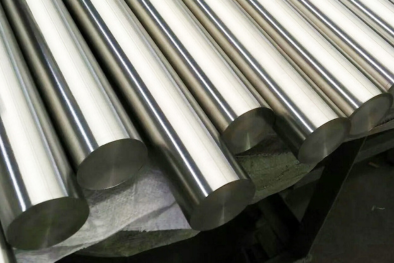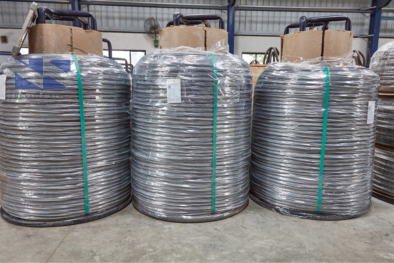Stainless Steel A286
Stainless Steel A286 is a precipitation-hardenable super-alloy based on iron. The material finds use in applications requiring high strength, paired with corrosion resistance up to 1300 °F (700 °C). Besides, the alloy has other favorable properties, including excellent fabrication characteristics, low-temperature non-magnetic strength [down to -320 °F (-196 °C)], and ductility.
Thanks to its unique properties, Stainless Steel finds use in various aircraft components, including jet engine components, fasteners, and springs. Moreover, the material is used in industrial gas turbines, aqueous solutions with moderate corrosion properties, and non-magnetic cryogenic parts. Other applications include high-temperature afterburner parts, tanks, piping, pumps, heat exchangers, and superchargers in the automotive industry.
Meanwhile, despite the fact that A286 is harder than similar nickel or cobalt-based stainless steel, it can be easily machined and formed by cold-drawing. Furthermore, depending on the application, A286 can be solution annealed or age-hardened, while additional cold-working elevates the creep strength substantially.


Stainless Steel A286, also known as Alloy A286, is a high-strength, corrosion-resistant stainless steel alloy that is commonly used in a variety of high-temperature and high-stress applications. Here is some information about Stainless Steel A286:
- Stainless Steel A286 contains various elements, with the following composition:
- Iron (Fe): Makes up the majority of the alloy.
- Nickel (Ni): Approximately 24-27%.
- Chromium (Cr): Approximately 13.5-16%.
- Titanium (Ti): Approximately 1.9-2.35%.
- Manganese (Mn): Approximately 2.0% max.
- Silicon (Si): Approximately 1.0% max.
- Cobalt (Co): Approximately 1.0% max.
- Vanadium (V): Approximately 0.1-0.5%.
- Molybdenum (Mo): Approximately 0.3-1.3%.
- Sulfur (S): Approximately 0.03% max.
- Phosphorus (P): Approximately 0.025% max.
- Carbon (C): Approximately 0.08% max.
- High Strength: Stainless Steel A286 is known for its high tensile and yield strength, making it suitable for applications where mechanical strength is crucial.
- Corrosion Resistance: It offers good corrosion resistance, particularly in high-temperature and harsh environments.
- High-Temperature Performance: A286 retains its mechanical properties at elevated temperatures, making it ideal for use in heat-resistant applications.
- Applications: Stainless Steel A286 is commonly used in a wide range of applications, including but not limited to:
- Aerospace: Jet engine components, fasteners, and turbine blades.
- Automotive:Exhaust systems and fasteners.
- Oil & Gas:Drill collars and downhole tools.
- Power Generation:Components for gas turbines.
- Medical:Surgical instruments and orthopedic implants.
It’s important to select the appropriate form and follow the manufacturer’s recommendations for welding and fabrication to maintain the material’s properties in different applications.
We also provide :
Material Certification and Traceability
At Satyam Overseas, we prioritize Material Certification and Traceability. Our materials, meeting ASTM and ASME standards, come with 3.1 Mill Test Certificates as a guarantee of compliance. Additionally, upon request, we provide 3.2 Mill Test Certificates for added assurance. Every material is clearly marked and accompanied by a corresponding certificate, meticulously linking markings to certification. This meticulous approach ensures complete accountability and unwavering reliability throughout our supply chain.
Chemical Composition
| Element | Iron (Fe) | Nickel (Ni) | Chromium (Cr) | Titanium (Ti) | Manganese (Mn) | Silicon (Si) | Aluminum (Al) | Vanadium (V) | Carbon (C) |
|---|---|---|---|---|---|---|---|---|---|
| Composition Range | 47.5 – 51.5% | 24.0 – 27.0% | 13.5 – 16.0% | 1.9 – 2.35% | 1.0 – 2.0% | ≤ 1.0% | 0.35 – 1.0% | 0.1 – 0.5% | ≤ 0.08% |
physical properties
| Property | Density | Melting Range | Specific Heat Capacity | Thermal Conductivity | Electrical Resistivity | Young's Modulus (E) | Poisson's Ratio (ν) |
|---|---|---|---|---|---|---|---|
| Value | 7.94 g/cm³ (0.286 lb/in³) | 1371 – 1432°C (2500 – 2610°F) | 0.461 J/g°C (0.11 Btu/lb°F) | 15.0 W/m·K (10.3 Btu·in/ft²·h·°F) | 0.94 μΩ·m (93 μΩ·in) | 196 GPa (28,400,000 psi) | 0.30 |